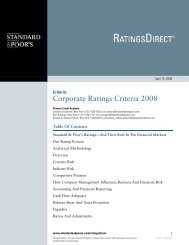European Infrastructure Finance Yearbook - Investing In Bonds ...
European Infrastructure Finance Yearbook - Investing In Bonds ...
European Infrastructure Finance Yearbook - Investing In Bonds ...
Create successful ePaper yourself
Turn your PDF publications into a flip-book with our unique Google optimized e-Paper software.
TRANSPORTATION INFRASTRUCTURE<br />
82 ■ NOVEMBER 2007<br />
Credit And Cash Flow Evaluation<br />
Standard & Poor’s analysis focused on a stressed<br />
business plan and EBITDA levels from the<br />
management’s base case. The company’s case that<br />
was used for the debt restructuring was<br />
elaborated in 2005 on reasonable assumptions.<br />
Standard & Poor’s implemented a 20% haircut<br />
to the net present value (NPV) of the company’s<br />
net cash flow (NCF) (equivalent to 23% of the<br />
sum of revenues) on the life of the transaction. <strong>In</strong><br />
this case, the business grows on average by a<br />
nominal 2.2% per year. Bearing in mind that<br />
Eurotunnel’s management case is already<br />
operating at a fairly low level, Standard & Poor’s<br />
estimates that the level of stress implemented is<br />
commensurate with a ‘BBB’ rating.<br />
Eurotunnel’s significant tax loss carry-forward<br />
allows all the pre-tax cash flow to be used for<br />
NCF DSCR (scheduled)<br />
STANDARD & POOR’S EUROPEAN INFRASTRUCTURE FINANCE YEARBOOK<br />
debt service in the first 10 years or so.<br />
NCF is used for the DSCR calculation. At the<br />
borrower level, under the management base case,<br />
the minimal scheduled NCF DSCR is at 1.48x<br />
(first year); it then improves, reflecting the<br />
expected volumes and cash flow growth. Under<br />
Standard & Poor’s stressed case, the ratio reaches<br />
a minimum of 1.36x in year six when principal<br />
amortization kicks off. This is a low but<br />
acceptable ratio for a concession with<br />
volume risk. That is above the 1.1x event of<br />
default covenant.<br />
The results from the cash flow analysis are<br />
shown in table 4.<br />
As a result of Standard & Poor’s cash flow<br />
analysis, £2.9 million (or 10.5x forecast EBITDA)<br />
is considered commensurate with a ‘BBB’ rating.<br />
Given the hybrid nature of the business, the<br />
Table 4 - Cash Flow Analysis Compared Outcomes Under Management And Standard & Poor’s Cases<br />
June 30, June 30, June 30, June 30, June 30, June 30, June 30, June 30, June 30, June 30,<br />
2008 2009 2010 2011 2012 2013 2014 2015 2016 2017<br />
Management<br />
case (x)<br />
Standard & Poor’s<br />
1.48 1.54 1.62 1.67 1.75 1.59 1.63 1.73 1.90 2.05<br />
case (x) 1.47 1.44 1.46 1.49 1.53 1.36 1.40 1.44 1.48 1.53<br />
Debt/(EBITDA-essential capex)<br />
Management<br />
case (x)<br />
Standard & Poor’s<br />
12.53 12.11 11.54 11.18 10.72 10.28 10.01 9.41 8.52 7.89<br />
case (x) 12.64 12.90 12.81 12.53 12.27 11.95 11.58 11.22 10.87 10.52<br />
Synthetic DSCR (NCF/(Higher of actual and synthetic DS))<br />
Management<br />
case (x)<br />
Standard & Poor’s<br />
1.33 1.37 1.45 1.50 1.56 1.59 1.63 1.73 1.90 2.05<br />
case (x)<br />
NCF ICR<br />
Management<br />
1.31 1.29 1.30 1.33 1.36 1.36 1.40 1.44 1.48 1.53<br />
case (x)<br />
Standard & Poor’s<br />
1.48 1.54 1.62 1.67 1.75 1.82 1.88 2.01 2.23 2.42<br />
case (x)<br />
(FFO + interest)/interest<br />
Management<br />
1.47 1.44 1.46 1.49 1.53 1.56 1.62 1.68 1.74 1.80<br />
case (x)<br />
Standard & Poor’s<br />
1.75 1.80 1.92 1.99 2.00 2.07 2.17 2.28 2.42 2.58<br />
case (x)<br />
FFO/Net debt<br />
Management<br />
1.72 1.70 1.68 1.70 1.72 1.76 1.82 1.88 1.95 2.02<br />
case (%)<br />
Standard & Poor’s<br />
9.2 9.4 10.0 10.4 10.4 10.8 11.3 11.9 12.5 13.3<br />
case (%) 9.1 8.9 8.8 8.9 9.0 9.2 9.5 9.8 10.1 10.4



